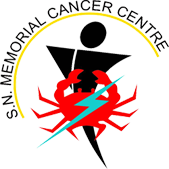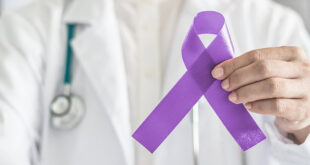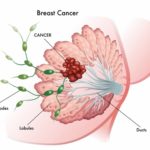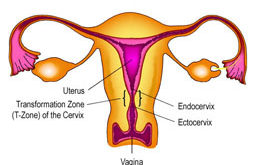Changes or mutations in DNA can cause normal breast cells to become cancer. Certain DNA
changes are passed on from parents (inherited) and can greatly increase the
risk for breast cancer. Other lifestyle-related risk factors, such as what you eat and how much you exercise, can increase your chance of developing breast cancer, but it’s not yet known exactly how some of these risk factors cause normal cells to become cancer. Hormones seem to play a role in many cases of breast cancer, but just how this happens is not fully understood.
Inherited versus acquired DNA mutations
Normal breast cells become cancer because of changes (mutations) in DNA. DNA is the chemical in each of our cells that makes up our genes. Genes have the instructions for how our cells function. Some DNA mutations are inherited or passed to you from your parents. This means the mutations are in every cell in your body and certain mutations can greatly increase the risk of certain cancers. They cause many of the cancers that run in some families.
But most DNA changes linked to breast cancer are acquired. This means the change takes place in breast cells during a woman’s life rather than having been inherited. Acquired DNA changes take place over time and are only in the breast cancer cells, not in every cell in the body.
Mutated DNA can lead to mutated genes. Some genes control when our cells grow, divide into new cells, and die. Changes in these genes are linked to cancer.
Oncogenes
Genes that speed up cell division are called oncogenes.
Proto-oncogenes are genes that normally help cells grow. When a proto-oncogene mutates
(changes) or there are too many copies of it, it becomes a “bad” gene that can stay turned on or activated when it’s not supposed to be. When this happens, the cell grows out of control and makes more cells that grow out of control. This can lead to cancer. This bad gene is called an oncogene.
Think of a cell as a car. For the car to work properly, there need to be ways to control how fast it goes. A proto-oncogene normally functions in a way that’s much like a gas pedal. It helps control how and when the cell grows and divides. An oncogene is like a gas pedal that’s stuck down, which causes the cell to divide out of control.
Tumor suppression genes
Tumor suppressor genes are normal genes that slow down cell division, repair DNA mistakes, or tell cells when to die (a process known as apoptosis or programmed cell death). When tumor suppressor genes don’t work properly, cells can grow out of control and make more cells that grow out of control, which can lead to cancer.
A tumor suppressor gene is like the brake pedal on a car. It normally keeps the cell from dividing too quickly, just as a brake keeps a car from going too fast. When something goes wrong with the gene, such as a mutation, the “brakes” don’t work and cell division can get out of control.
Inherited gene changes
Certain inherited DNA mutations (changes) can dramatically increase the risk for
developing certain cancers and are linked to many of the cancers that run in
some families. For instance, the BRCA genes (BRCA1 and BRCA2) are tumor suppressor genes. When one of these genes changes, it no longer suppresses abnormal cell growth, and cancer is more likely to develop. A change in one of these genes can be passed on from a parent.
Women have already begun to benefit from advances in understanding the genetic basis of
breast cancer. Genetic testing can identify some women who have inherited
mutations in the BRCA1 or BRCA2 tumor suppressor genes (or less commonly in other genes such as PTEN or TP53). These women can then take steps to reduce their risk of breast cancers and make plans to look for changes in their breasts to help find cancer at an earlier, more treatable stage.
Mutations in tumor suppressor genes like the BRCA genes are considered “high-penetrance” because they often lead to cancer. Although many women with high-penetrance mutations develop cancer, most cases of cancer (including breast cancer) are not caused by this kind of mutation.
More often, low-penetrance mutations or gene variations are a factor in cancer development.
Each of these may have a small effect on cancer occurring in any one person, but the overall effect on the population can be large because the mutations are common, and people often have more than one at the same time. The genes involved may affect things like hormone levels, metabolism, or other things that impact risk factors for breast cancer. These genes may cause much of the risk of breast cancer that runs in families.
Acquired gene changes
Most DNA mutations related to breast cancer take place in breast cells during a woman’s
life rather than having been inherited. These acquired mutations of oncogenes and/or tumor suppressor genes may result from other factors, like radiation or cancer-causing chemicals. But so far, the causes of most acquired mutations that could lead to breast cancer are still unknown. Most breast cancers have several acquired gene mutations.
Tests to spot acquired gene changes may help doctors more accurately predict the outlook
(prognosis) for some women with breast cancer. For example, tests can identify women whose breast cancer cells have too many copies of the HER2 oncogene. These cancers tend to grow and spread faster. There are drugs that target these cancer cell changes and improve outcomes for patients.
Learn more about genes changes and how they can affect cancer risk and treatment in our
section on breast cancer risk and prevention.
 Female Cancer Specialist Doctor in Kanpur female, doctor, cancer, specialist, female, oncologist, oncology, medical, oncologist, chemotherapy, breast, blood, mammography, prostate, center, hospital, radiotherapy, surgery, mouth, kanpur, sn, memorial, female, doctor, cancer, specialist,
Female Cancer Specialist Doctor in Kanpur female, doctor, cancer, specialist, female, oncologist, oncology, medical, oncologist, chemotherapy, breast, blood, mammography, prostate, center, hospital, radiotherapy, surgery, mouth, kanpur, sn, memorial, female, doctor, cancer, specialist,




